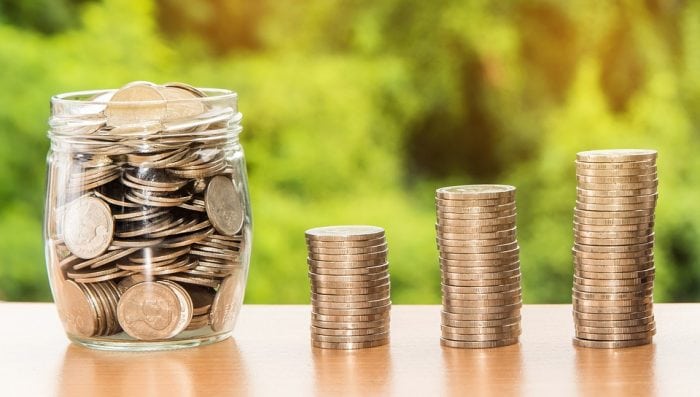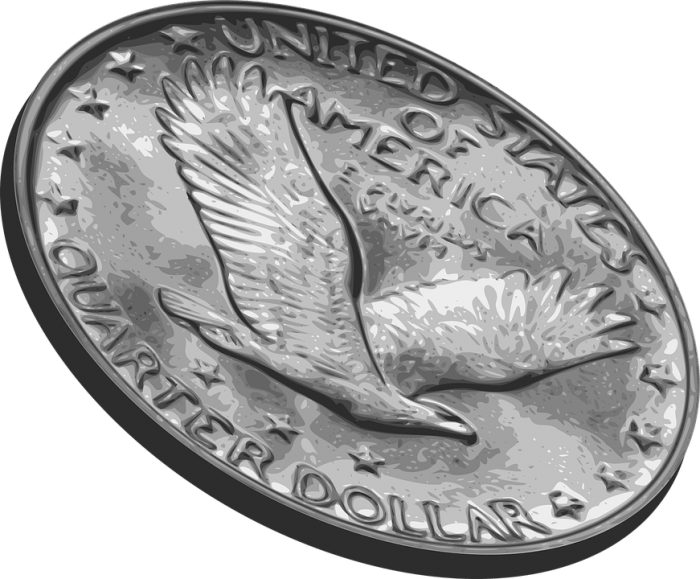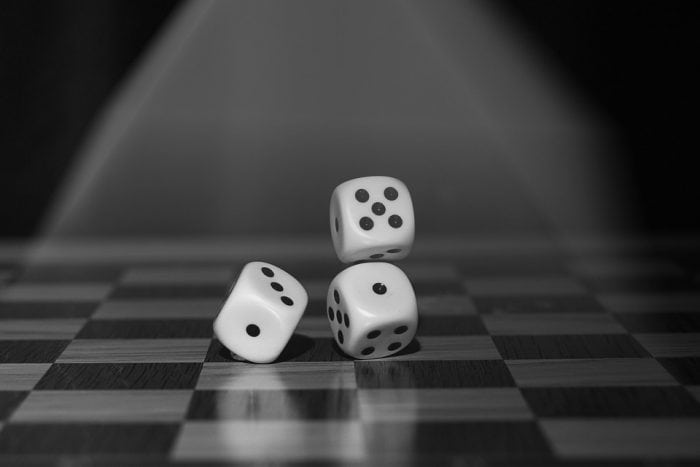How To Tell If A Coin Flip Data Set Is Fake

If you flip a coin, there'south a fifty percent take chances (probability) the coin will country on heads a fifty percent chance it will state on tails, anybody knows this. Nonetheless due west hat is the probability that you would get two heads in a row if you flipped the coin twice?
What about 3 heads in a row, or four heads in a row? What is the probability that you will ringlet 2 sixes in a row if you rolled a dice twice? This discussion of bones probability will explicate how y'all tin determine the odds in simple probability problems and explicate some important probability concepts.
Probability And Money Flips

Photo: zsunberg via Pixabay, CC0
I of the most mutual probability questions involving coins is this: "Permit's presume that you flip a money five times and the coin lands on heads all five times. What is the probability that the money will land on heads once more?"
The answer to this is always going to be 50/fifty, or ½, or l%. Every flip of the coin has an "independent probability", significant that the probability that the coin will come heads or tails is only affected by the toss of the coin itself. The coin has no desire to continue a detail streak, and so it's not affected by any number of previous coin tosses. The idea that a serial of outcomes in a probabilistic scenario will go along simply considering one is "on a roll" is closely related to the Gambler's fallacy.
Hither's some other common question in probability: "If you were to flip four coins, what are the chances that they would all come heads?"
In this situation, you have four coins that are all contained events. Then in this case, the right calculation to determine the probability is:
½ x ½ 10 ½ x ½ = 1/16
Every flip of the coin doesn't depend on the other money flips, and we are dealing with a situation where one matter must occur as well equally several other things. This is an "and" situation. When dealing with "and" situations, you lot must multiply the probabilities together. Remember, "and" means multiplication. Every flip has a probability of ½, so when these probabilities are multiplied together the probability of getting all heads on 4 coin flips is 1/16.
What if you were asked for the probability that a coin would come upwardly heads four times in a row if a coin was flipped twenty times in a row? As seen in the smaller instance above, there should be an "and" condition for every ane of the xx flips. And then nosotros're looking for the probability of:
(½)^20 , which can exist expressed as 1/(20)^twenty
Substantially, when doing this computation we are computing the value of ½ times ½ times ½, etc. repeated twenty times. You lot tin apply this formula to whatsoever number of times a coin is flipped if you're looking for the aforementioned consequence anytime, just fill in "North" with the number of times yous flip the coin:
(½)^N
Notation that while the odds of getting heads 20 times in a row are extremely low, approximately one in a million, if nosotros had every American acquit this experiment many people would actually find that they were successful in getting twenty heads in a row, considering of the sheer amount of people doing the experiment. Call up this when unlikely events seem to occur, that there are millions of events taking place every day and we but pay attention to the ones that are relevant to united states.
Die Probabilities

Photo: 955169 via Pixbay, CC0
Let's move on to calculating die probabilities. The probability of one side coming up on a dice are slightly more than complex than the probability that a confront will come up up on a coin, but still adequately simple to understand. The easiest case to examine when calculating probability with dice is the odds that a side volition come up upward when throwing a unmarried dice. If you're looking for the probability that a six will come upwards when you throw a die, employ the following formula:
Probability = Number of desired outcomes/number of possible outcomes.
And so the odds for rolling a specific outcome, no affair if that outcome is 1, 4, or 6 is simply calculated past:
Probability = ⅙ = 0.167
Remember that probability 0 is no chance, while probability i is a sure thing. If you want this number as a percentage, only catechumen the decimal into a percent, by dividing the denominator of the fraction into the numerator. The adventure of rolling a 6 on a dice is sixteen.7 per centum, and this is also the probability of rolling whatsoever other face of the dice. Then what are the chances of rolling two sixes in a row? It's the aforementioned principle as the in a higher place example with the money flips, these are both independent probabilities that we are examining. So the probability of getting 6s on a die in a row is merely the probability of the first outcome multiplied past the probability of the 2d outcome.
The probability of rolling 2 sixes in a row = ⅕ x ⅙ = 1/36
Now simply divide 36 into one to become 0.0278, or expressed every bit a per centum – two.78%.
How would the probability change if we wanted to know the probability of getting two dissimilar numbers on a die? If you wanted to know the probability that you would roll a 2 and a three on both rolls of the die, just recall near it in this sense: You're interested in ii dissimilar outcomes, and these outcomes don't accept to occur in a specific club. This means that if you're interested in getting a two or a 3, the calculations break down like this:
Probability = num of desired outcomes / num of possible outcomes = 2/35 = 0.0556.
Or as a per centum, 5.56%.
What about if you wanted to know how likely information technology would be that you would get a certain score by rolling ii or more dice, you could utilize the same formula you have been to determine this. Note that it can be rather complicated, nevertheless, to count up all the possible outcomes that would give you the number you are interested in achieving. For instance, if you are interested in getting a 4 or a set of two dice, you could exercise this past rolling ii 2s, a iii and a one or a ane and a 3. Notation that ane and 3 and 3 and 1 are separate outcomes, you take to consider both of the outcomes separately.
How To Tell If A Coin Flip Data Set Is Fake,
Source: https://sciencetrends.com/flip-a-coin-basic-probability/
Posted by: gilbertformem.blogspot.com


0 Response to "How To Tell If A Coin Flip Data Set Is Fake"
Post a Comment